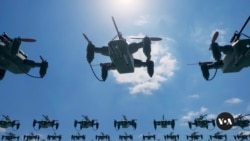ຢູເຄຣນ ແລະ ຣັດເຊຍ ກໍາລັງນຳໃຊ້ເຮືອບິນບໍ່ມີຄົນຂັບ ຫຼື ໂດຣນ ຢູ່ສະໜາມລົບໃນຢູເຄຣນ. ແລະອີງຕາມຜູ້ຊ່ຽວຊານ ທາງການທະຫານຂອງສະ ຫະລັດ, ກອງທັບໂດຣນຂະຫນາດນ້ອຍ ສາມາດດໍາເນີນການປົກກະຕິໃນການສູ້ລົບຢູ່ໃນສົງຄາມສະໄຫມໃໝ່ໄດ້. ແຕ່ການພັດທະນາລະບົບອາວຸດທີ່ເປັນອິດສະຫຼະແລະອັນຕະລາຍຂອງໂລກໄດ້ສ້າງຄວາມວິຕົກກັງວົນເພີ້ມຂຶ້ນ. ມາເອຍ ເຄ (Maia Kay) ນັກຂ່າວ VOA ມີລາຍງານ, ເຊິ່ງ ທິບສຸດາ ມີລາຍລະ ອຽດ.
ໃນເດືອນສິງຫາ, ທໍານຽບ 5 ແຈ ໄດ້ປະກາດຂໍ້ລິເລີ້ມໃນການຜະລິດໂດຣນຊະນິດໃຫມ່ ທີ່ມີຊື່ວ່າ "Replicator" ອັນເປັນວິທີການແຂ່ງຂັນກັບກອງທັບຂອງຈີນໄດ້ດີກວ່າ. ກະຊວງປ້ອງກັນປະເທດກ່າວວ່າ ໂຄງການດັ່ງກ່າວ ແມ່ນການ
ສົ່ງໂດຣນຂະໜາດນ້ອຍໆເປັນຈໍານວນຫຼວງຫຼາຍ ລົງສູ່ສະໜາມລົບ, ເຊິ່ງເປັນ “ການປ່ຽນແປງເພື່ອເຮັດໃຫ້ເກມປ່ຽນໄປ” ໃນດ້ານຄວາມໝັ້ນຄົງແຫ່ງຊາດຂອງສະຫະລັດ.
ທ່ານມາກ ເຈຄັອບເຊັນ (Mark Jacobsen), ຈາກມະຫາວິທະຍາໄລສົງຄາມທາງອາກາດ ກ່າວຜ່ານສໄກປ໌ ວ່າ:
“ເຮືອບິນບໍ່ມີຄົນຂັບຂະໜາດນ້ອຍ ໝາຍເຖິງການເປັນອິດສະຫຼະຂອງອາວຸດນຳວິຖີທີ່ມີຄວາມແມ່ນຢຳ ເຊິ່ງປັດຈຸບັນ ຜູ້ໃດກໍຕາມທີ່ມີເງິນບໍ່ເທົ່າໃດພັນໂດລາ ກໍສາມາດສ້າງອາວຸດທີ່ມີອໍານາດສູງໄດ້ ແລະແນ່ນອນທີ່ສຸດ, ໃນເມື່ອກ່ອນ ມີພຽງແຕ່ປະເທດທີ່ມີອໍານາດເທົ່ານັ້ນທີ່ເຂົ້າເຖິງໄດ້. ດັ່ງນັ້ນ, ຂ້າພະເຈົ້າຄິດວ່າ ພວກເຮົາຈະຍັງຄົງສືບຕໍ່ ເຫັນພວກມັນຢູ່ໃນສະໜາມລົບ.”
ພັນເອກ ມາກ ຈາຄັອບເຊັນ, ເຊິ່ງເປັນຜູ້ຊ່ວຍອາຈານສອນ ວິຊາຍຸດທະສາດ ແລະການສຶກສາທາງດ້ານຄວາມໝັ້ນຄົງ ຢູ່ທີ່ມະຫາວິທະຍາໄລສົງຄາມ ຂອງ
ກອງທັບອາກາດ ກ່າວຕໍ່ VOA ວ່າ ສົງຄາມຢູເຄຣນ ໄດ້ນຳໃຊ້ໂດຣນແບບບໍ່ເຄີຍມີມາກ່ອນ. ທ່ານກ່າວວ່າ ທະຫານຢູເຄຣນນໍາໃຊ້ໂດຣນລະຫວ່າງ 5 ພັນ ຫາ 10 ພັນລໍາຕໍ່ເດືອນ, ແລະຝຶກອົບຮົມໃຫ້ແກ່ຜູ້ປະຕິບັດການກ່ຽວກັບໂດຣນ ໂດຍສະເລ່ຍແລ້ວ 10 ພັນຄົນຕໍ່ປີ.
ເຮືອບິນບໍ່ມີຄົນຂັບບາງລຳ ທີ່ນຳໃຊ້ຢູ່ໃນສະໜາມລົບຂອງຢູເຄຣນ ມີຄວາມສາ ມາດຄວບຄຸມດ້ວຍໂຕມັນເອງ, ແລະປະກອບດ້ວຍອາວຸດທີ່ນຳໃຊ້ປັນຍາປະດິດ ເຊິ່ງສາມາດລະບຸ, ຕິດຕາມ ແລະໂຈມຕີເປົ້າໝາຍຕ່າງໆໂດຍບໍ່ມີການດໍາເນີນງານຈາກມະນຸດເລີຍ. ພັນເອກ ຈາຄັອບເຊັນ ກ່າວວ່າ ການດໍາເນີນງານແບບເປັນອິດສະຫຼະ ເຮັດໃຫ້ເກີດຄວາມກັງວົນ ກ່ຽວກັບຈັນຍາບັນບາງຢ່າງ ຕໍ່ການຕັດສິນໃຈຂອງເຄື່ອງຈັກ ເພື່ອທໍາການສັງຫານ, ເຊິ່ງທ່ານກ່າວຜ່ານສໄກປ໌ ວ່າ:
"ເນື່ອງຈາກສະພາບແວດລ້ອມ ໃນຄວາມສະຫຼັບຊັບຊ້ອນຂອງສົງຄາມເອເລັກໂຕຣນິກ ຫຼື EW, ຈຶ່ງຍາກທີ່ຈະຮັກສາການເຊື່ອມຕໍ່ຂໍ້ມູນໄດ້, ເຊິ່ງຈະມີການຜັກດັນລະບົບ ທີ່ມີຄວາມເປັນອິດສະຫຼະຫຼາຍຂຶ້ນ ແລະຫຼາຍຂຶ້ນກວ່າເກົ່າ, ຫຼື ໂດຣນ ສາມາດບິນດ້ວຍໂຕຂອງມັນເອງ ແລະດໍາເນີນການຕັດສິນໃຈດ້ວຍໂຕຂອງພວກມັນເອງ. ສິ່ງນັ້ນຈຶ່ງໄດ້ສ້າງຄວາມກັງວົນດ້ານຈັນຍາບັນຂຶ້ນມາທັນທີ.”
ທ່ານເຈມສ໌ ໂຣເຈີສ໌ (James Rogers), ຜູ້ອຳນວຍການຝ່າຍບໍລິຫານໃຫຍ່ຂອງສະຖາບັນນະໂຍບາຍ Brooks Tech ຢູ່ທີ່ມະຫາວິທະຍາໄລຄອລແນລ (Cornell) ກ່າວວ່າ ໂດຣນເປັນຜູ້ຕັດສິນໃຈທັງໝົດເຫຼົ່ານັ້ນ, ເຊິ່ງທ່ານກ່າວວ່າ:
“ລະບົບອາວຸດເຫຼົ່ານີ້, ເມື່ອເປົ້າໝາຍໄດ້ຖືກລະບຸໄວ້ໂດຍລະບົບກົນໄກທີ່ຖືກຕັ້ງໄວ້ລ່ວງໜ້າແລ້ວ, ພວກມັນຈະສາມາດເລືອກເອງໄດ້ວ່າ ມະນຸດຈະມີຊີວິດຢູ່ ຫຼື ຕາຍ ໂດຍບໍ່ມີຜູ້ໃດຄວບຄຸມມັນ. ສະນັ້ນ, ມັນສໍາຄັນຫຼາຍ ທີ່ຈະວາງແຜນເພື່ອອະນາຄົດ, ແຕ່ມັນ ກໍຍັງມີຄວາມສຳຄັນ ທີ່ພວກເຮົາຮັບຮອງໄດ້ວ່າ ອະນາຄົດ ຄື ປັດຈຸບັນນີ້.”
ອີງຕາມທຳນຽບຫ້າແຈ, ເຖິງແມ່ນໂດຣນ ຈະມີຄວາມສາມາດໃນປັດຈຸບັນ ແຕ່ກອງທັບສະຫະລັດ ກໍຈະຍັງຄົງປະຕິບັດການຝຶກຊ້ອມ ໃນອັນທີ່ພວກເຂົາເຈົ້າຮ້ອງວ່າ “ການຈັດການໃນລະດັບທີ່ເໝາະສົມຂອງມະນຸດ” ກ່ອນທີ່ຈະມີການນໍາໃຊ້ກຳລັງໃດໆກໍຕາມ. ແຕ່ພວກເຂົາເຈົ້າກ່າວວ່າ ພວກທ່ານບໍ່ສາມາດກາງຕໍ່ໄດ້ວ່າ ຄູ່ຕໍ່ສູ້ຄົນອື່ນໆ ຈະປະຕິບັດແບບດຽວກັນນີ້ຫຼືບໍ່.
Ukraine and Russia are using drones on the battlefields in Ukraine. And according to U.S. military experts, small drone armies could be a routine feature of modern warfare. But the global development of lethal autonomous weapons systems are raising some concerns. VOA’s Maia Kay reports.
In August, the Pentagon announced a new drone initiative dubbed “Replicator” as a way to better compete with China’s military. The Defense Department says the program, which depends on fielding large numbers of smaller drones, is a “game-changing shift” in U.S. national security.
Col. Mark Jacobsen, Air War College, male, Skype.
"Small drones essentially mean the democratization of precision guided munitions, where anybody in the world now with a few thousand dollars, can build extremely powerful and precise weapons, that previously only powerful countries would have had access to. So, I think we'll continue to see them on the battlefield.”
Mark Jacobsen, a U.S. colonel and assistant professor of strategy and security studies at the US Air Force’s Air War College, tells VOA the Ukraine war has been unprecedented in its use of air drones. He says Ukrainians are using between 5 to 10 thousand drones a month, and train on average 10 thousand drone operators a year.
Some of the drones being used on Ukrainian battlefields have autonomous capabilities, and are equipped with Artificial Intelligence-enabled munitions that can identify, track, and attack targets without human intervention. Jacobsen says that autonomy raises some ethical concerns about machines making the decision to kill.
Col. Mark Jacobsen, Air War College, male, English, Skype.
“Because of the complex EW (Electronic Warfare) environment, it's so hard to maintain data links. There's a greater and greater push towards autonomy, or drones could fly themselves and make some of their own decisions. That very quickly runs into ethical concerns.”
James Rogers, the executive director of Brooks Tech Policy Institute at Cornell University, says drones are already making those decisions.
James Rogers, Cornell University, male.
“… these weapon systems, once the target has been identified by its preset algorithm, well, they can make that choice, about whether or not a human lives or dies, without a human being in the loop of control. So, it's important to plan for the future but it's also vital we recognize that that future is now.”
According to the Pentagon, even if drones have the capability now, the U.S. military will always exercise what it calls “appropriate levels of human judgement” before any force is used. But they say you can’t count on other combatants to do the same.






ຟໍຣັມສະແດງຄວາມຄິດເຫັນ